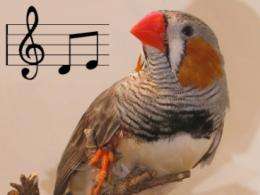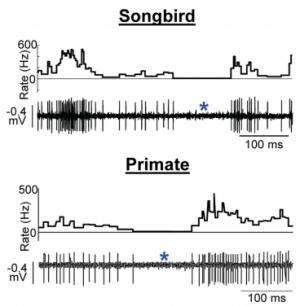Birds and mammals share a common brain circuit for learning

(PhysOrg.com) -- Bird song learning is a model system for studying the general principles of learning, but attempts to draw parallels between learning in birds and mammals have been difficult because of anatomical brain differences between the two species.
A new study from researchers at MIT and Hebrew University helps solve this problem, by identifying specific classes of neurons within the brains of songbirds and matching them to their mammalian counterparts.
The study focuses on the basal ganglia, brain structures that play a key role in skill learning and habit formation and are also linked to many disorders, including Parkinson’s disease, obsessive-compulsive disorder, and drug addiction. Mammalian basal ganglia consist of several structures, including the striatum and the globus pallidus, both of which are centrally involved in Parkinson’s disease.
There is growing evidence that similar brain circuits are also present in birds, in which these circuits appear to underlie song learning. In birds, however, there are no anatomical divisions, and the different basal ganglia cell types are intermixed within a tiny (~1mm) structure known as ‘area X.’ Jesse Goldberg and Michale Fee at MIT’s McGovern Institute for Brain Research recorded electrical activity from individual neurons in the brains of young zebra finches, using a motorized microdrive to position the electrodes precisely within area X.

Based on their patterns of electrical activity while the birds were singing, the researchers identified two distinct classes of neurons that show different firing patterns. The researchers compared their recordings with the activity patterns recorded from the two known anatomical pathways in the monkey globus pallidus. Although firing rates are much faster in birds (up to 700 spikes per second, among the fastest of any neurons), the patterns are otherwise highly similar between the two species. Additionally, the researchers confirmed that one of the two classes in birds forms the same types of connections as their primate counterparts.
The new findings appear in the May 26 issue of Journal of Neuroscience. In a separate study, recently published in Journal of Neurophysiology, Goldberg and Fee reported that other neurons in area X exhibit activity similar to four known classes of neurons within the mammalian striatum.
“Our results strongly suggest that the same brain circuits underlie learning in birds and mammals, despite the superficial differences of anatomy,” says Goldberg. “This circuit must have evolved at least 300 million years ago, before birds and mammals diverged.”
Bird song learning is a very stereotyped form of learning and is an ideal model system in which to understand general principles that are involved with the learning of complex actions. The new findings support the idea that such lessons are likely to be relevant to human biology and to the treatment of human disorders such as Parkinson’s disease.
More information: "Singing-related neural activity distinguishes two putative pallidal cell types in the songbird basal ganglia: comparison to the primate internal and external pallidal segments." Goldberg JH, Adler A, Bergman H, Fee MS. Journal of Neuroscience. 2010 May 19.
Provided by Massachusetts Institute of Technology















